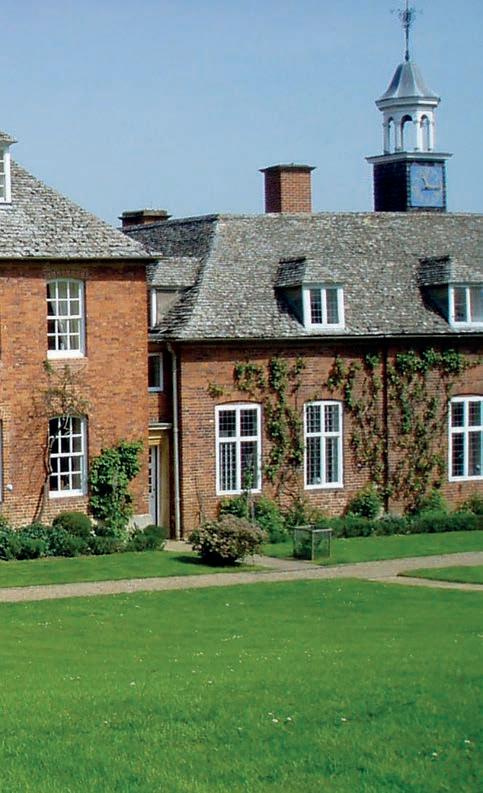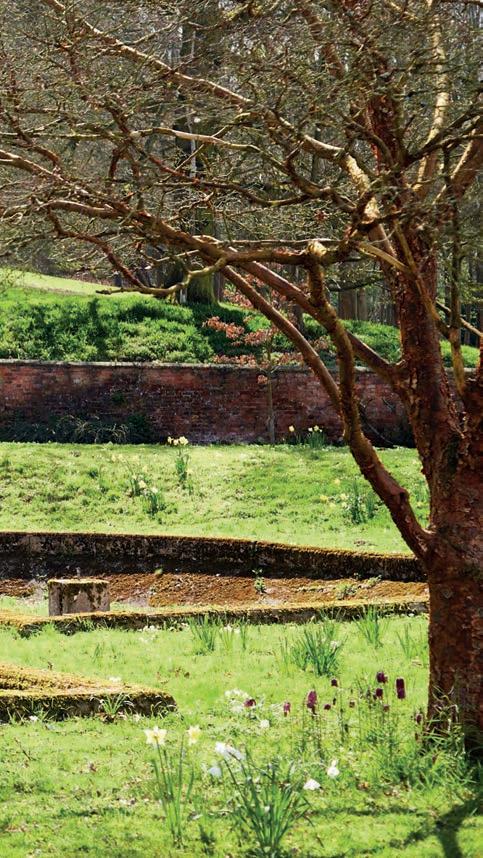
3 minute read
Burnt Norton
Heather Holden-Brown (1968)
interviews Caroline Sandon, owner of Burnt Norton (site of Tudor Hall School 1939–46) and author of the novel of the same name...

I met Caroline Sandon at her home, Burnt Norton, in the heart of the Cotswolds, on a sunny spring day earlier this year. On her lap was black and white cocker spaniel, Poppy, which seemed apt for a house which had welcomed Tudor Hall School from the outbreak of the Second World War until it moved to the newly acquired Wykham Park near Banbury in 1946. During a recent visit by OTs from that era, Caroline discovered that from their bedrooms at the top of the house the girls had witnessed the German air raid on Coventry on the night of 14th November, 1940, flames high in the sky which could be seen from over thirty miles away. And in the local church St James’s, in Chipping Campden, there is a shining altar rail and plaque as a lasting testament to Tudor’s time at Burnt Norton.

Caroline Sandon
Burnt Norton in Spring.
Caroline (Lady Harrowby) and I had much to discuss – present-day Tudor Hall (where Caroline’s daughter Clemmie Coram James (2005) and step-daughter Emily Ryder (2010) were educated, now a barrister and graphic designer respectively), T S Eliot’s Four Quartets, the first of which was inspired by the breathtaking beauty of Burnt Norton’s gardens and views, and Caroline’s first novel, published in 2013, Burnt Norton.
Burnt Norton has been described by Julian Fellowes, the creator of Downton Abbey, as ‘a powerful story, beautifully told, of love and betrayal, greed and tragedy’. How right he is. It was a book I looked forward to getting back to at the end of every day. Caroline’s fascinated and assiduous research into the


history of Burnt Norton brought to life the story of the Keyt family, who lived at ‘Norton House’ in the early eighteenth century. Tragedy had befallen the family and grief sent Sir William Keyt, MP for Warwick, to seek consolation in the arms of Molly Johnson, his wife’s maid. He built a splendid and costly house for Molly by the side of Norton House but in 1741, mad with lasting grief and drink, he set fire to himself and the house – hence the renaming of the original manor house as Burnt Norton. Sir William’s son Thomas was also deeply in love with Molly and their son (whose existence remained unknown to him) was one of the children ‘adopted’ by the philanthropist Thomas Coram and brought up in London’s Foundling Hospital before being sent away to sea.

The Baroque temple built by Keyt still stands in Burnt Norton’s magnificent grounds, surrounded by trees which in 1738 cost Sir William the princely sum of 10,000 guineas. The poet T S Eliot first came to the house in 1934 with his friend Emily Hale who lived in Chipping Campden. As he came through the white wooden gate into its beautiful gardens, he was inspired to write in the first of his quartets: "Time present and time past Are both perhaps present in time future, And time future contained in time past. ... Footfalls echo in the memory Down the passage which we did not take Towards the door we never opened Into the rose-garden. ... Disturbing the dust on a bowl of rose-leaves I do not know. Other echoes Inhabit the garden. Shall we follow? Quick, said the bird, find them, find them, Round the corner. Through the first gate, Into our first world, shall we follow..." R
Caroline’s most recent novel, A Paris Secret, written as Caroline Montague, is the story of Sophie Bernot, a heart surgeon training in troubled postwar Paris, determined to succeed in a man’s world. David Watson, an eminent retired heart surgeon who lives locally in Gloucestershire, was a great friend and support to Caroline in her research for A Paris Secret. www.carolinemontague.co.uk

Left: Caroline Sandon in Burnt Norton grounds.
Below: The two Burnt Norton dogs.











